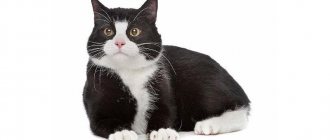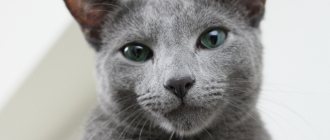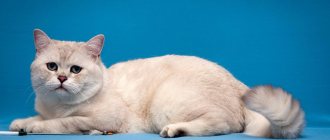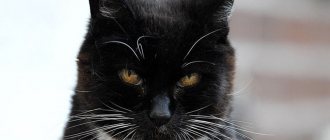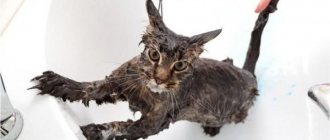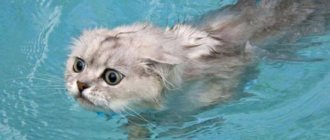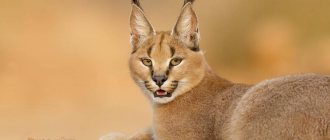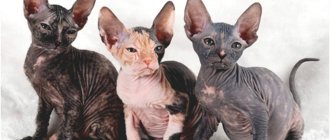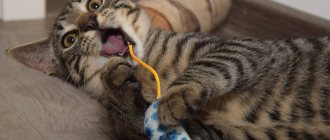Gray cats have always been the center of attention, and their silver-blue coat has long been associated with moonlight and was considered a sign of aristocracy. And today, animals with a smoky color are recognized as the personification of internal harmony and emotional stability. It is not surprising that they are in great demand among ordinary owners and professional breeders.
Let's find out which cat breeds are characterized by gray fur.
History of the breed
The progenitors of this breed once lived in the Arkhangelsk province, which was located in the north of the Russian Empire. Its characteristic feature is the presence of dark blue dense wool with a silver tint.
As a rule, these gentle creatures with emerald eyes were kept in their chambers by Russian monarchs and their retinue. Peter the Great had a cat, Vaska, who could travel freely through the royal chambers, happily accepting the caresses of all the courtiers he met.
Subsequently, the heir to the royal throne, Elizaveta Petrovna, was no less loving towards her four-legged pets with blue fur. Only Catherine the Second was indifferent to such unique creatures, although quite often she presented these unique animals as gifts to overseas high-ranking guests.
Interesting guess! According to many experts, this is how the blue cat appeared in Britain at one time, when the queen presented it as a gift to the English king.
In 1893, Constance Carew-Cox brought 3 cats and one male cat from Arkhangelsk, after which she began to practice breeding this breed. No one could stop the breeding of Russian blue cats, and in 1901 another cat joined this company. These animals have always been visually different from other breeds of blue cats, both British and European, not only in their behavior, but also in their appearance.
The Arkhangelsk cat was extremely popular due to its natural grace, elegant physique, and double bluish-silver fur. They were valued because they had a fairly docile character and never made loud sounds, even during periods of heat. These cats have always been quiet, delicate and, at the same time, secretive.
✔ Russian Blue cat is a short-haired breed of blue color with green eyes
Symbolism of color
In most world cultures, this color is considered a symbol of calm and peace.
Major religions view it differently:
- Christianity. All Christians are sure that the color of the sky induces humility and piety. The Virgin Mary is often depicted in a blue cloak, and Catholics present her with blue flowers. They symbolize purity, integrity and devotion to God.
- Buddhism. Here this shade is a symbol of motherhood, love and compassion for one’s neighbor. For them, it is associated with harmony, tranquility and spirituality.
- Judaism. All shades of this color symbolize holiness.
- Islam. For Muslims, this color is associated with mourning and sadness.
In ancient Rome, rich people painted blue veins on their arms and legs to emphasize their divine origin.
Christian clergy in colored robes.
Problems with selection
After the October events of 1917, work on breeding this breed intensified. Purebred breeding became irrelevant as the “iron curtain” was lowered on breeders. The word “Russian” was removed from the name of the breed and replaced with the word “foreign”. Only in 1939 this breed was recognized as the original “Russian Blue”.
European breeders had no choice but to start crossing similar breeds. The appearance of the Russian Blue was greatly modified by the genes of the Siamese cat, so one could notice clear signs of their presence by the following characteristics:
- The presence of a head with a straight wedge-shaped profile.
- The ears are large and widely spaced.
- Limbs are elongated.
- The coat is short and the undercoat is poorly developed.
It is important to know! The behavior of the Russian Blue also changed noticeably, as the cats began to emit loud meows, and the cats began to mark corners, which is completely unusual for a purebred Russian Blue cat. In the middle of last year, American breeders continued the practice of mixing real Arkhangelsk cats with Siamese.
As for British breeders, they took a different route, crossing them with British Shorthairs. As a result, the Arkhangelsk cat became the owner of an impressive mass and large bones.
The use of blue color in the interior
When using this tone in the interior, consider the following:
- all rooms associated with water, such as a bath, shower, sauna, toilet, swimming pool, etc., look good in blue design;
- the relaxing effect of such shades allows them to be used when decorating relaxation rooms;
- when decorating a room facing the sunny side, this solution will help reduce the feeling of heat, stuffiness and relax;
- If you decorate a cafe in this color scheme, women will love it, because... the color is associated with sweets, desserts must be on the menu;
- When decorating sports rooms, you need to carefully use such colors, because... they slow down the psyche, cause laziness, so the effectiveness of classes decreases.
Homecoming
This happened in the 80s of the last century, when the first blue cats were imported from Czechoslovakia.
Unfortunately, the exterior of these cats was significantly spoiled by the genes of Siamese cats, and therefore needed the same significant adjustment. In this regard, breeders first of all set about ridding animals of these alien traits, which include:
- Profile orientation.
- Poorly developed undercoat.
- Lack of silver tint on the coat.
Without the presence of a purebred Russian Blue cat, further breeding work lost all meaning, since it was most suitable due to the fact that it was more consistent with breed standards. Russian blue cats had their main characteristics:
- The eyes are round in shape.
- Characteristic angular profile.
- The whisker pads have a characteristic swelling.
- The coat is long (moderately).
- The undercoat is dense and well developed.
- Color blue with a silver tint.
In addition, the Russian Blue cat was characterized by having a friendly, docile character, compared to the wild disposition of the Siamese.
Italian Greyhound
Starting from the 16th century, there are references to a small greyhound. This is a very graceful, intelligent animal. When permanently living in the rooms, it leaves almost no odors. It has thin, short hair that fits tightly to the body. He gets used to it very quickly and is sensitive to his owner. Loves to walk, but does not tolerate rainy weather.
Among dogs with a blue color there are both hunting and indoor specimens, guard dogs, and sports dogs. Regardless of their purpose, animals need care and attention. For this they pay the owner with loyalty and love.
- Author: Elena Romanenko
Rate this article:
- 5
- 4
- 3
- 2
- 1
(8 votes, average: 3.8 out of 5)
Share with your friends!
Pedigree varieties
As a result of crossing various breeds of cats with the Russian Blue cat, 4 types of Russian Blue cats appeared:
- The American type was distinguished by a pronounced manifestation of oriental features, as well as an early manifestation of the color of the iris (by 4 months of age).
- The European type has a very unique coat color and no undercoat.
- The Scandinavian type is distinguished by the presence of undercoat, has a round head and a massive body.
- The Russian type can be considered the standard version of the Russian Blue cat, although the breed is characterized by a protracted period of change in eye color, as well as unsatisfactory coat length.
Whippet
An old breed of dog. Similar ones are found in images dating back to the 4th-5th centuries. BC e. Very often present next to the image of the goddess Diana. It is considered officially bred at the beginning of the 19th century. The dog was adapted for racing, which was a hobby for the aristocracy. Can reach speeds of up to 56 km/h. Has short hair. An excellent hunter of rabbits and rats. Requires intensive training for endurance training, very affectionate with the owner.
Appearance
The Russian Blue cat is considered a medium-sized animal, with a body weight of around 5 kg. This elegant and fit animal has a coat similar to that of British cats, while the rather thick coat visually makes the animal’s neck shorter.
We can assume that the tail is not long, and the limbs are elongated, with the hind limbs being somewhat longer than the front ones. The paws are oval shaped. The ears are quite large, the nose is straight, and the head is wedge-shaped. The whisker pads are very noticeable.
The Russian Blue's eyes are almond-shaped, widely spaced, and green in color, which gives these cats a special charm. It should be noted that the color of the iris of the eyes can have different shades of green.
Interesting to know! Kittens that are born have blue eyes, but after a long time, as they grow and develop, which can take years, the eye color will turn green.
The characteristic appearance of the Russian Blue cat is due to its dense double fur, which has a silver shimmer. An important fact to note is that the length of the coat and undercoat are almost the same. The metallic sheen is formed due to the bleached ends of the guard hairs.
If the animal is characterized as stocky, with a pronounced oriental type, as well as the presence of a round or quadrangular head, close-fitting fur, large-shaped eyes, a relatively wide tail at the base, the presence of yellow inclusions in the main color, as well as the presence of white stripes color and spots on the coat, then this can be safely attributed to breed defects.
Cane Corso
The breed almost became extinct by the 70s of the 20th century, but through the efforts of breeders the numbers began to increase. The name is interpreted as “bodyguard dog”. A large, very strong and energetic animal. It is so faithful to its owner that it amazes and is considered the best guard for the family. At the same time, he loves small children and takes tender care of them. The dog's coat is very short and dense, shiny, but hard to the touch. The Cane Corso is easy to train if training begins at an early age. Otherwise it may become aggressive.
Russian blue cat color
Breed standards indicate that the main color of these cats, from ears to tail to the tips of the paws, should be blue-gray, without the presence of any streaks, spots or stripes. Kittens may have a kind of “ring” on their tail, which disappears as the animal grows, although the case when this “ring” remains will not be considered a flaw. The nose should always stand out and be darker in relation to the color of the coat. The paw pads are dark pink in color.
As a rule, fashion always changes along with the preferences of the owners, so recently animals with lighter coat colors have become more in demand, although not so long ago, preference was given to darker pets.
French Bulldog
The breed was developed in England. Used as a companion for the owner and as a home rat trap. The dogs were popular among English seamstresses. Then they appeared on the continent, becoming a prestigious breed among the French aristocracy. The animal is small in size, very strong and agile. Distinctive features are short hair and a muzzle with a flat nose. The dog is very cheerful and active. He is distinguished by his special love for children, coming to their defense in case of danger.
Description of character
This is a breed that is suitable for any family, including those with small children. The cat gets along both with one owner and in a family with many household members. The cat easily switches from a calm state to an active one, happily communicating with fairly active children and adolescents.
He does not allow himself to react negatively to even the most careless treatment of children, therefore he never shows aggression. The only exceptions are dogs, who for some reason really don’t like cats, and cats pay them back in kind.
They also do not allow themselves to remember grievances, so they will never dare to deliberately harm their owner. The Russian Blue cat reacts to intonation, to words and to gestures, so it can always understand what its owner wants from it: it will never dare to disobey.
Important point! Despite the fact that this pet has an easy-going character, it does not allow itself to be cuddled for a long time, especially if it is a stranger.
The Russian Blue cat is a natural hunter who can hunt anything that flies, jumps and runs. It is especially interesting to watch how a cat hunts all kinds of insects if there is no potential prey in the form of birds nearby. She will not calm down until she manages to swat the annoying fly with one throw.
Weimaraner
The Weimaraner, or Weimar pointer, has been used for hunting for many years. Its breeding dates back to the beginning of the 19th century and is attributed to the German Duke Karl August. In Weimar, it was customary to call it the “silver ghost” for its unusual coat color: from silver-gray to mouse color with various transitions between them. The animal is very obedient when trained, quickly finds a common language with the owner and becomes a devoted friend. Weimaraners love movement, so country life is very suitable for them.
Maintenance and care
The peculiarity of this purebred breed is that after it there are no odors in the apartment indicating cat excretions. In addition, these cats practically do not lose hair, so it can be recommended for people suffering from allergies to cat hair. The coat will always be in order if you brush it at least once a week. It is not necessary to bathe such a pet, unless it participates in various exhibition shows. A cat sheds 2 times a year. During this period, it is advisable to include oats or grass in the animal’s diet to remove hair from the stomach.
According to some owners of this breed, the use of ready-made factory feed as food leads to darkening of the animal's coat. Therefore, you need to be careful with your diet and prepare diets in accordance with the recommendations of breeders or veterinarians. Despite this, the diet should consist of 75 percent dry food and 25 percent wet food.
The Russian Blue cat has excellent genes that are responsible for its health. A cat of this breed can live about 15 years, and with good care and maintenance, without stress, even more.
Russian Blue cat ➠ Find out everything about the cat breed
Kerry Blue Terrier
Dogs of this breed were also bred in Ireland at the beginning of the 19th century by crossing an Irish terrier with a wolfhound. At the same time, we managed to improve the flair and preserve the original color. The animal was used to guard the house and hunt foxes and game birds. There is information that it also served as a herding dog. The main decoration of the breed is its thick, soft, wavy coat. He loves movement and running. Timely training of a pet is of great importance. If training is not started at an early age, the dog becomes aggressive.

